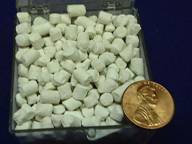Навигация
10.2 Present-day spelling
Most countries spell aluminium with an i before -um. In the United States, the spelling aluminium is largely unknown, and the spelling aluminum predominates.[48][49] The Canadian Oxford Dictionary prefers aluminum, whereas the Australian Macquarie Dictionary prefers aluminium.
The International Union of Pure and Applied Chemistry (IUPAC) adopted aluminium as the standard international name for the element in 1990, but three years later recognized aluminum as an acceptable variant. Hence their periodic table includes both.[50] IUPAC officially prefers the use of aluminium in its internal publications, although several IUPAC publications use the spelling aluminum.[51]
11. Health concerns
Despite its natural abundance, aluminium has no known function in living cells and presents some toxic effects in elevated concentrations. Its toxicity can be traced to deposition in bone and the central nervous system, which is particularly increased in patients with reduced renal function. Because aluminium competes with calcium for absorption, increased amounts of dietary aluminium may contribute to the reduced skeletal mineralization (osteopenia) observed in preterm infants and infants with growth retardation. In very high doses, aluminium can cause neurotoxicity, and is associated with altered function of the blood-brain barrier.[52] A small percentage of people are allergic to aluminium and experience contact dermatitis, digestive disorders, vomiting or other symptoms upon contact or ingestion of products containing aluminium, such as deodorants or antacids. In those without allergies, aluminium is not as toxic as heavy metals, but there is evidence of some toxicity if it is consumed in excessive amounts.[53] Although the use of aluminium cookware has not been shown to lead to aluminium toxicity in general, excessive consumption of antacids containing aluminium compounds and excessive use of aluminium-containing antiperspirants provide more significant exposure levels. Studies have shown that consumption of acidic foods or liquids with aluminium significantly increases aluminium absorption,[54] and maltol has been shown to increase the accumulation of aluminium in nervous and osseus tissue.[55] Furthermore, aluminium increases estrogen-related gene expression in human breast cancer cells cultured in the laboratory.[56] These salts' estrogen-like effects have led to their classification as a metalloestrogen.
Because of its potentially toxic effects, aluminium's use in some antiperspirants, dyes (such as aluminum lake), and food additives is controversial. Although there is little evidence that normal exposure to aluminium presents a risk to healthy adults,[57] several studies point to risks associated with increased exposure to the metal[citation needed]. Aluminium in food may be absorbed more than aluminium from water.[58] Some researchers have expressed concerns that the aluminium in antiperspirants may increase the risk of breast cancer,[59] and aluminium has controversially been implicated as a factor in Alzheimer's disease.[60]
According to The Alzheimer's Society, the overwhelming medical and scientific opinion is that studies have not convincingly demonstrated a causal relationship between aluminium and Alzheimer's disease.[61] Nevertheless, some studies[which?] cite aluminium exposure as a risk factor for Alzheimer's disease, as some brain plaques have been found to contain increased levels of the metal[citation needed]. Research in this area has been inconclusive; aluminium accumulation may be a consequence of the disease rather than a causal agent. In any event, if there is any toxicity of aluminium, it must be via a very specific mechanism, since total human exposure to the element in the form of naturally occurring clay in soil and dust is enormously large over a lifetime.[62][63] Scientific consensus does not yet exist about whether aluminium exposure could directly increase the risk of Alzheimer's disease.[61]
12. Effect on plants
Aluminium is primary among the factors that reduce plant growth on acid soils. Although it is generally harmless to plant growth in pH-neutral soils, the concentration in acid soils of toxic Al3+ cations increases and disturbs root growth and function.[64][65][66]
Most acid soils are saturated with aluminium rather than hydrogen ions. The acidity of the soil is therefore a result of hydrolysis of aluminium compounds.[67] This concept of "corrected lime potential"[68] to define the degree of base saturation in soils became the basis for procedures now used in soil testing laboratories to determine the "lime requirement" of soils.[69]
Wheat's adaptation to allow aluminium tolerance is such that the aluminium induces a release of organic compounds that bind to the harmful aluminium cations. Sorghum is believed to have the same tolerance mechanism. The first gene for aluminium tolerance has been identified in wheat. It was shown that sorghum's aluminium tolerance is controlled by a single gene, as for wheat.[70] This is not the case in all plants.
13. Conclusion
As an individual representative of the periodic table of chemical elements Dmitry Ivanovich Mendeleyev, the element has unique chemical and physical properties
Element is of great economic importance and plays a major role in world culture
14. References
^ Magnetic susceptibility of the elements and inorganic compounds, in Handbook of Chemistry and Physics 81th edition, CRC press.
^ Bassam Z. Shakhashiri. "Chemical of the Week: Aluminum". Science is Fun. http://scifun.chem.wisc.edu/chemweek/Aluminum/ALUMINUM.html. Retrieved 2007-08-28.
^ a b Polmear, I. J. (1995). Light Alloys: Metallurgy of the Light Metals. Arnold. ISBN 9780340632079.
^ Dieter G. E. (1988). Mechanical Metallurgy. McGraw-Hill. ISBN 0070168938.
^ H. A. Macleod (2001). Thin-film optical filters. CRC Press. pp. 158-159. ISBN 0750306882.
^ John F. Cochran and D. E. Mapother (July 1958). "Superconducting Transition in Aluminum". Physical Review 111 (1): 132–142. doi:10.1103/PhysRev.111.132.
^ Applying lime to soils reduces the Aluminum toxicity to plants. "One Hundred Harvests Research Branch Agriculture Canada 1886-1986". Historical series / Agriculture Canada - Série historique / Agriculture Canada. Government of Canada. http://epe.lac-bac.gc.ca/100/205/301/ic/cdc/agrican/pubweb/hs270060.asp. Retrieved 2008-12-22. Note this link loads slowly
^ J. V. Magalhaes et al. (2004). "Comparative Mapping of a Major Aluminum Tolerance Gene in Sorghum and Other Species in the Poaceae". Genetics 167: 1905. doi:10.1534/genetics.103.023580.
Похожие работы
... . The advertising idea is defined. Advertising strategy is however insufficiently clearly stated. We will take advantage of the given reserve for increase of efficiency of an advertising campaign of Open Company "Натали", i. e. we will develop advertising strategy. 3.3 Use of methods of optimization in advertising activity One of optimisation methods in advertising activity is use of ...
... in 1975 together with Paul Alien, his partner in computer language development. While attending Harvard in 1975, Gates together with Alien developed a version of the BASIC computer programming language for the first personal computer. In the early 1980s. Gates led Microsoft's evolution from the developer of computer programming languages to a large computer software company. This transition ...
... , weight, our distinctive marks.That are shown in the blank enclosed. Plz observe all these requirements or we’ll have to refuse the offer with no charges payed. Ex 2: Write a letter for your firm to an English engineering firm, ordering a special machine. Give packing and marking instructions. thx u for offer of april 1.we r very interested in this sort of machine & would like to order 5 ...
... of lithium were produced through the electrolysis of lithium chloride by Robert Bunsen and Augustus Matthiessen.[20] The discovery of this procedure henceforth led to commercial production of lithium metal, beginning in 1923 by the German company Metallgesellschaft AG, which performed an electrolysis of a liquid mixture of lithium chloride and potassium chloride.[20][29] The production and use ...





0 комментариев